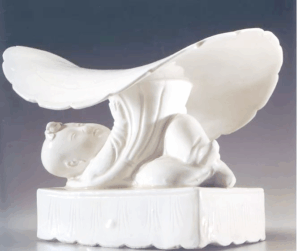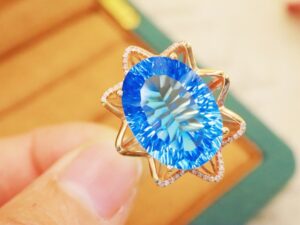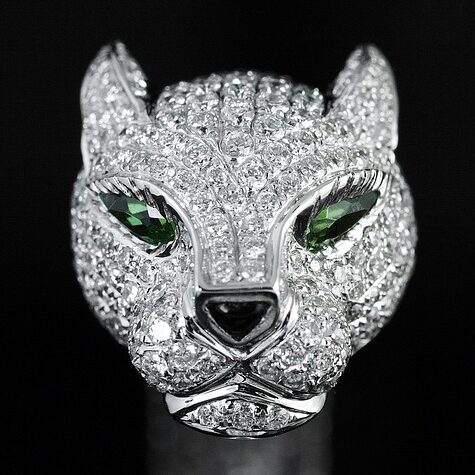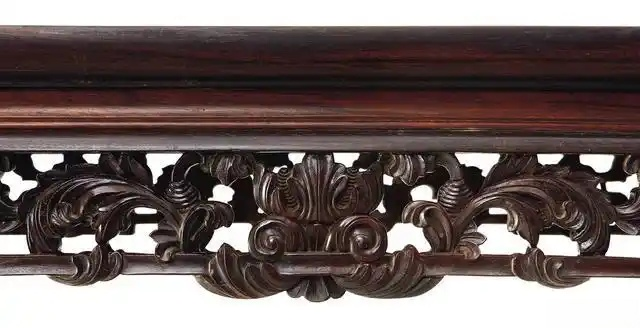
Qianlong Garden: Masterful Interior Wood Carving Decor
乾隆花園:巧奪天工的室內木雕紋飾
In Chinese ancient architecture, the Qing Dynasty represents the pinnacle of refined interior decoration, particularly during the Qianlong era of the Kang-Qian Golden Age. The development of Qianlong-period furniture and wood carving benefited from socioeconomic growth, evolving from folk craftsmanship to achieve technical excellence and superior materials—representing the highest achievement in traditional Chinese wood carving decoration.
在中國古代建築中,裝修最精細的當屬清代,而其中尤以康乾盛世中的乾隆朝為最。乾隆時期家具及木雕裝飾的形成和發展,得益於當時社會經濟的發展,是在民間家具木雕技藝的基礎上發展起來的。它技藝精湛,用材精良,代表了中國傳統家具木雕裝飾的最高水平。
Imperial vs. Folk Craftsmanship
宮廷與民間工藝之別
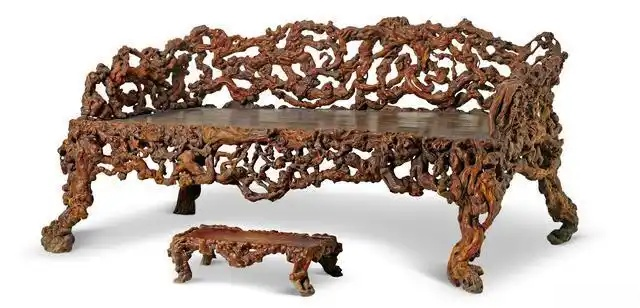
天然木羅漢床及足踏 故宮博物院藏
Qing imperial wood carving differed fundamentally from folk techniques through the Imperial Workshops system. Under the Zaobanchu (造辦處), specialized departments like engraving, enameling, gilding, lacquering, and ivory carving could collaborate across materials and techniques—providing technical support unimaginable to independent craftsmen.
清代宮廷木雕與民間木雕工藝的最大不同在於,清宮造辦處管轄的「鏨花作」、「琺瑯作」、「鍍金作」、「漆作」、「牙作」等各個工藝部門可以在材料和技藝上相互配合,合作完成作品,具有民間木雕匠人無法比擬的技術支撐。
During Ming-Qing periods, highly educated literati participated in wood carving design. They integrated their understanding of painting and calligraphy aesthetics into furniture design, elevating carving beyond mere craftsmanship to create what became known as “literati wood carving.”
明清時期,有大批文化修養很高的文人參與了木雕的設計。他們把對書畫藝術的理解和審美感受,融合到家具陳設的設計、裝飾中,促進了木雕藝術的繁榮。這種雕刻風格盡脫匠氣,品味高雅的作品被稱為文人木雕。
Common Decorative Motifs
常見裝飾紋樣
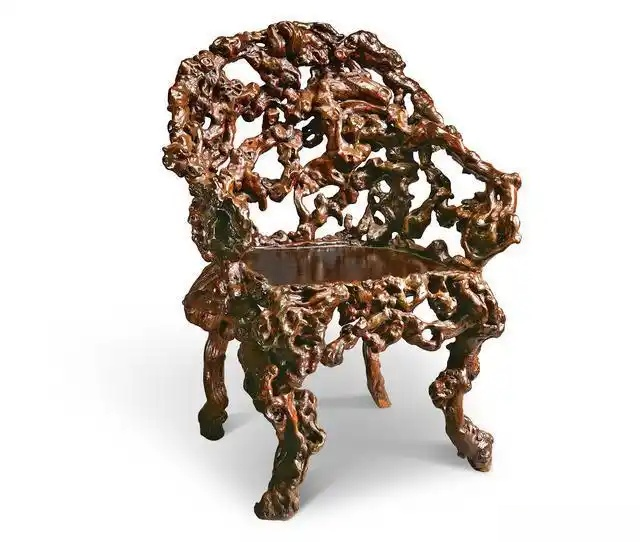
天然木桌、椅 故宮博物院藏
Ming-Qing imperial wood carving featured several characteristic patterns:
明清宮廷木雕的紋飾常見以下題材:
1. Dragon Patterns (龍紋)
一、龍紋
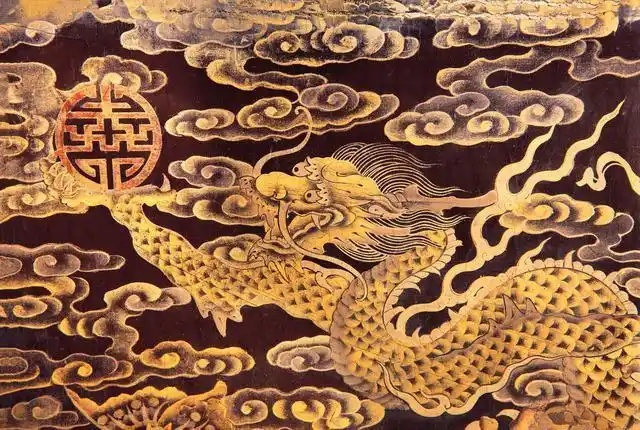
紅漆描金龍紋
The dragon, China’s most significant mythical creature and auspicious symbol, appeared predominantly in imperial contexts following ritual protocols. Ming-Qing dragon patterns typically appeared majestic and imposing, with cloud-dragon motifs being most common.
龍是中國最重要的神物和祥瑞。基於禮儀制度的規範,明清家具上的龍紋多見於宮廷中,大都規整威嚴,氣勢雄偉,以雲龍紋飾最普遍。
2. Three Friends of Winter (松竹梅)
二、歲寒三友
Zitan table screen with inlaid jade, pine, bamboo and plum (detail), Palace Museum Collection
紫檀木嵌玉松石玉竹梅玻璃插屏(局部) 故宮博物院藏
The ancients cherished the “Three Friends of Winter”—pine, bamboo, and plum—for their symbolic resilience during harsh seasons. Qianlong Garden interiors extensively employed these motifs. Later expanded to the “Four Gentlemen” (plum, orchid, bamboo, chrysanthemum), these plant themes elegantly solved design challenges: three sides for “Three Friends,” four sides for “Four Gentlemen.”
古人愛「松竹梅」,稱之為「歲寒三友」,取其寒冬時節仍能保存頑強生命力的象徵精神。乾隆花園建築室內裝修裝飾大量採用松、竹、梅題材。類似以植物表達文人气質的還有「梅蘭竹菊」,明時起稱「四君子」。有了「三友」和「四君子」之後,解決了不少裝飾設計的問題。
3. Interlocking Branch Patterns (纏枝紋)
三、纏枝紋(卷草紋)
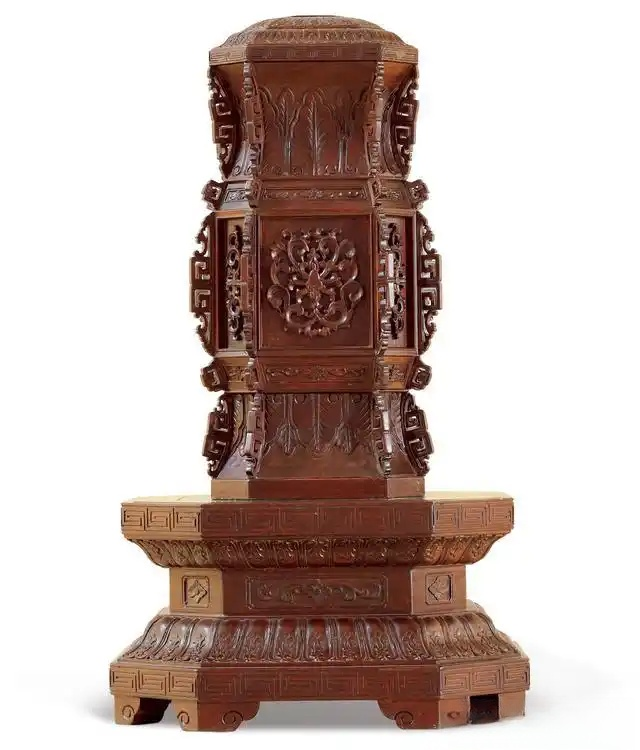
硬木宮扇底座 故宮博物院藏
Interlocking branch patterns, traditional auspicious motifs, symbolize “endless continuity” and longevity (hence别名 “Ten Thousand Longevity Vines”). Combinations created “interlocking peonies,” “interlocking lotus,” “interlocking grapes,” and “interlocking figures with animals.”
纏枝紋為傳統吉祥紋樣,因其結構連綿不斷,具「生生不息」之意,又名「萬壽藤」,寓意吉慶長壽。纏枝紋可與牡丹、蓮花、葡萄等組成各種變體。
Ming-Qing interlocking patterns displayed precision, richness, and magnificence, becoming common furniture decoration. The simplest form, often called “scroll grass pattern,” featured slightly curved leaves in symmetrical or continuous arrangements that harmonized beautifully with furniture lines.
明清時期的纏枝花紋嚴謹工整,豐富華麗。其中最簡單的形式常稱為「卷草紋」,可僅將草葉稍加彎曲變化,作對稱或連綴式,極易與家具的線腳呼應協調,故運用非常廣泛。
Technical Excellence
技術成就
Qianlong-era wood carving represents the culmination of several technical advantages:
乾隆時期木雕代表了多項技術優勢的頂峰:
- Material Access: Premium zitan, huanghuali, and rare woods
材料優勢:優質紫檀、黃花梨等珍稀木材 - Cross-Craft Integration: Combined metalworking, lacquering, stone inlay
工藝整合:結合金屬加工、漆藝、石料鑲嵌 - Literati Influence: Scholarly aesthetics elevating artistic conception
文人影響:文人審美提升藝術境界 - Imperial Patronage: Unlimited resources for ambitious projects
皇室支持:龐大資源支持宏偉項目
These factors created an unprecedented level of sophistication that continues to inspire wood artists today.
這些因素創造了前所未有的精緻水平,至今仍啟發著木雕藝術家。
Read More
- Collectors' Academy (145)
- Care Academy (7)
- Investment Academy (22)
- Jade Crafting Techniques (28)
- Michelle Au: The Gemstone Luminary (11)

